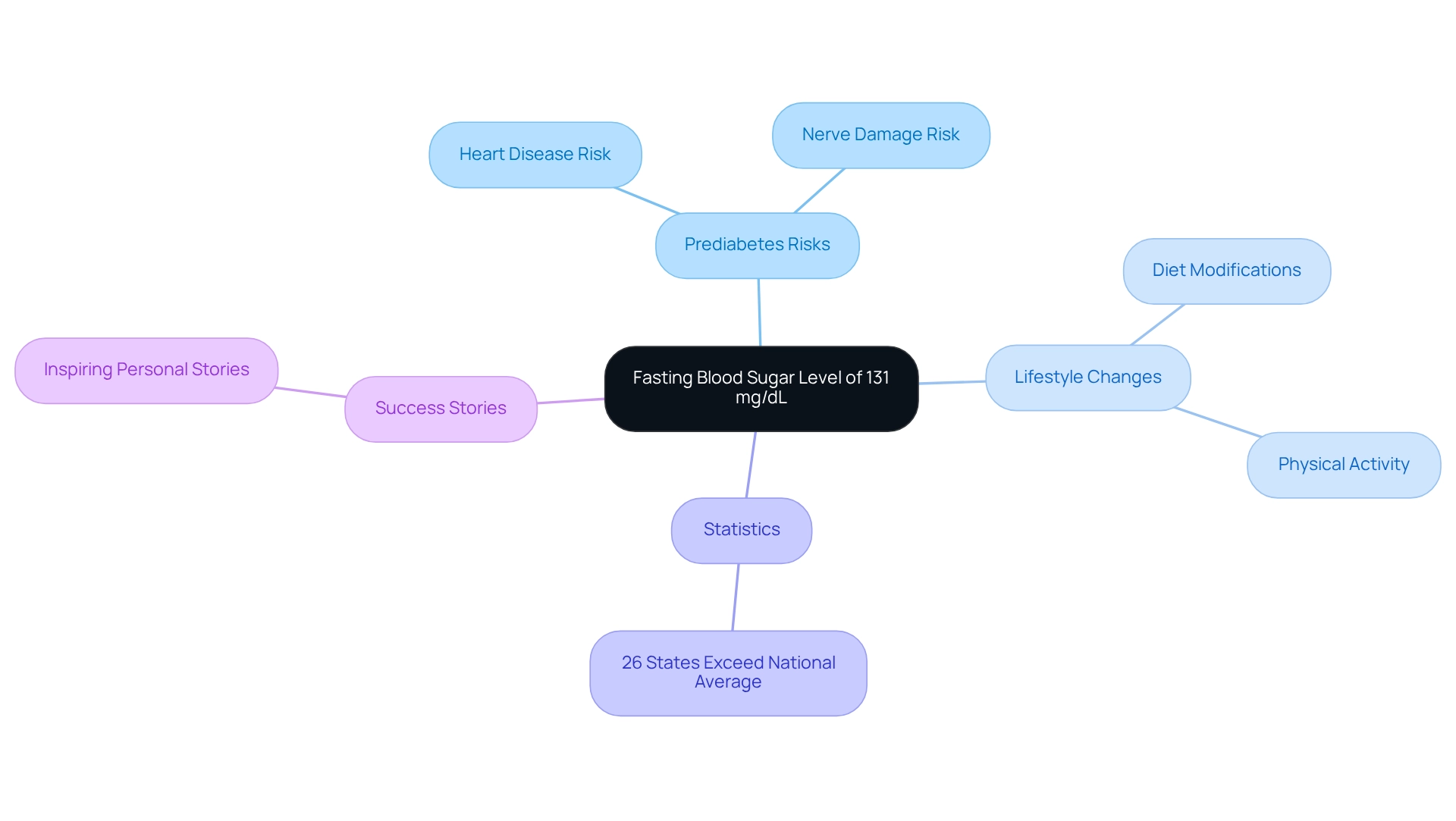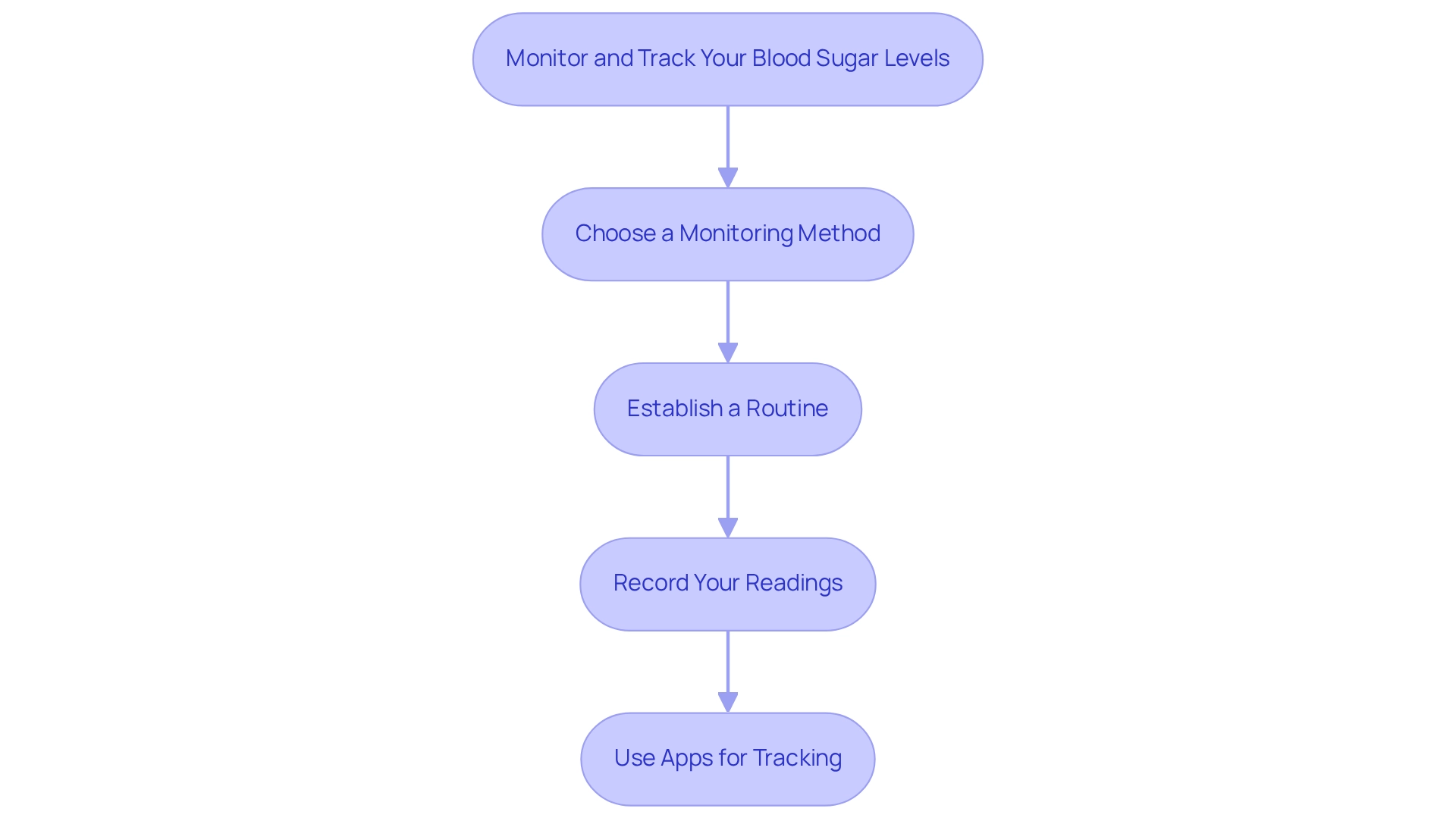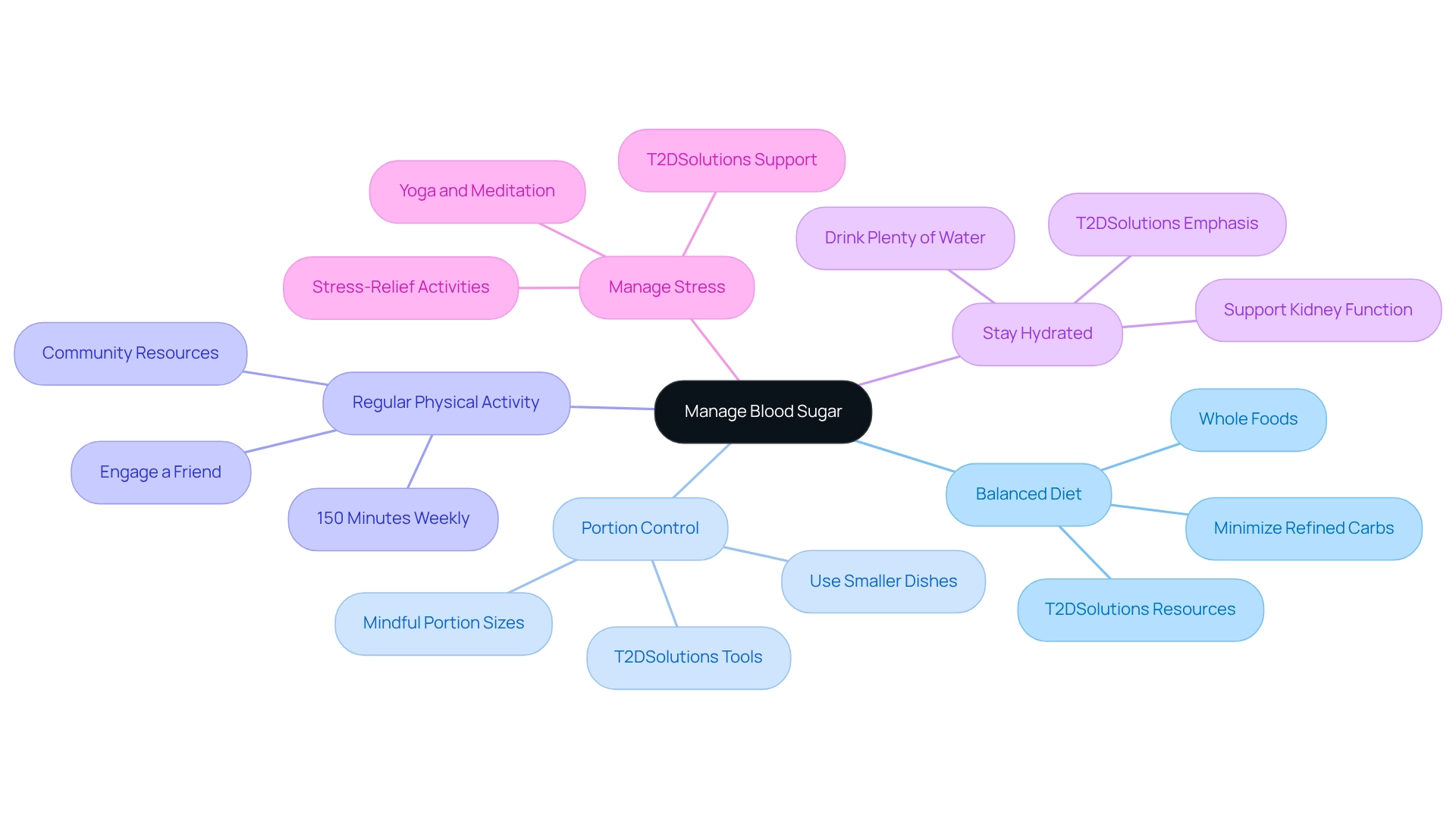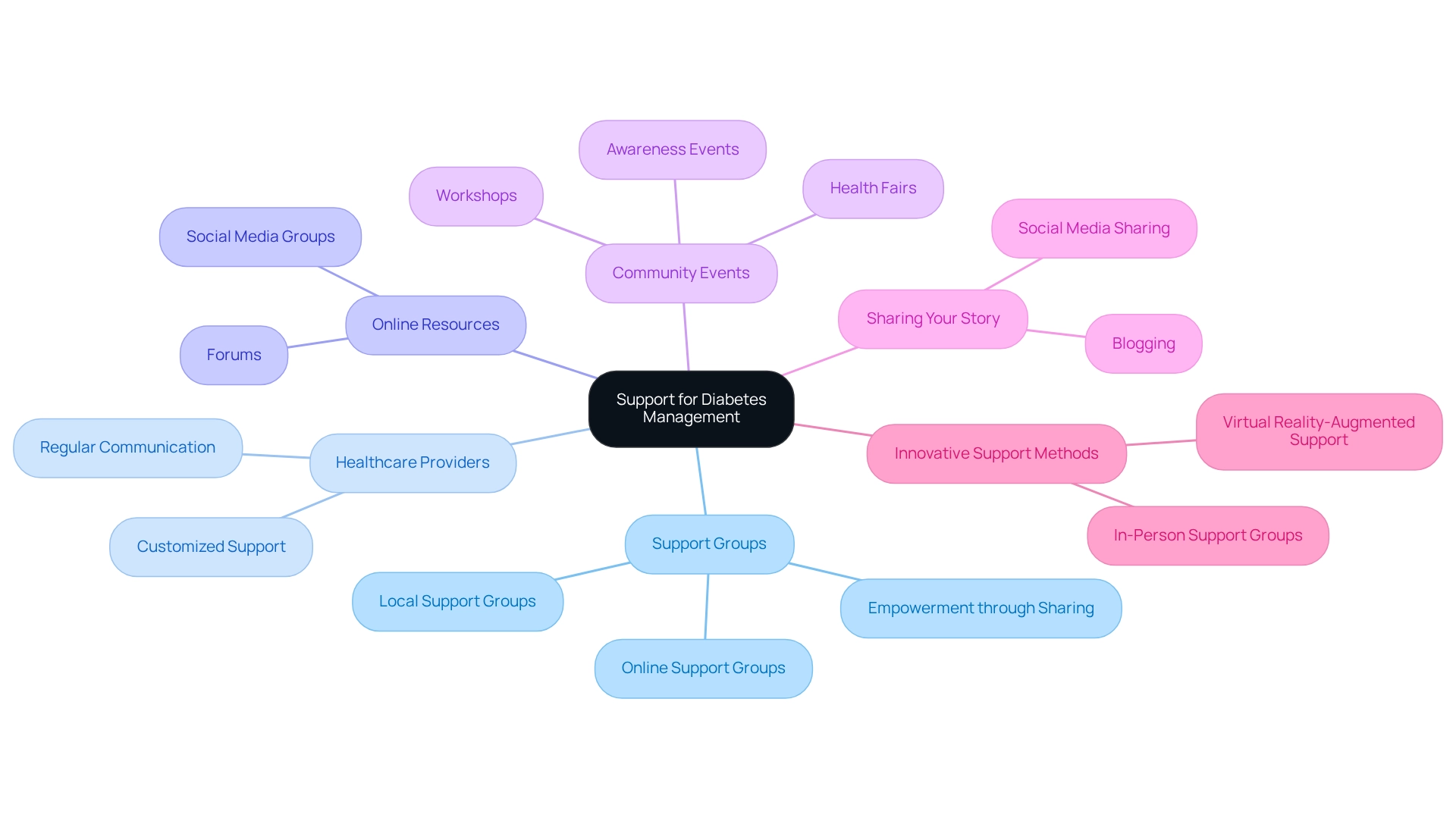Overview
Managing a fasting blood sugar level of 131 mg/dL can feel overwhelming, but there are supportive steps you can take. By adopting a balanced diet, increasing physical activity, and regularly monitoring your blood sugar, you can make a significant difference in your health. These lifestyle changes are not just beneficial; they can help prevent the progression to Type 2 diabetes and enhance your overall well-being.
It's understandable to feel uncertain about where to start. Research shows that lifestyle modifications can effectively manage blood glucose levels, offering hope and direction. You're not alone in this journey—many have found success through small, manageable changes.
Consider reaching out for support or resources that can guide you further. Remember, every step you take is a step toward a healthier future, and we are here to support you every step of the way.
Introduction
In a world where diabetes is increasingly prevalent, understanding blood sugar levels is more crucial than ever. A fasting blood sugar reading of 131 mg/dL signals the onset of prediabetes—a condition that, if left unaddressed, can escalate to Type 2 diabetes and its associated health risks. It's understandable to feel concerned about these numbers, especially with alarming statistics revealing that many regions in the U.S. surpass the national diabetes average. This reality underscores the importance of proactive health measures.
This article delves into the significance of monitoring blood sugar levels, implementing lifestyle changes, and seeking community support. By providing essential insights and practical strategies, we aim to empower you on your journey to better health. Remember, you're not alone in this journey. By taking informed steps today, the path to improved well-being and diabetes management becomes clearer. We are here to support you every step of the way.
Understand Your Fasting Blood Sugar Level of 131
A fasting blood sugar measurement of 131 sugar level mg/dL places you in the prediabetes range, defined as 100 to 125 mg/dL. This reading suggests that your body is having difficulty using insulin effectively, leading to higher glucose levels in your bloodstream. Recognizing this measurement is essential; it empowers you to take proactive steps toward better health. If left unaddressed, prediabetes can progress to Type 2 diabetes, significantly increasing the risk of serious complications, including heart disease and nerve damage.
Currently, statistics reveal that 26 states and territories in the U.S. have a prevalence of prediabetes that exceeds the national average. This highlights the urgent need to address this condition within your community. Healthcare professionals emphasize that simple lifestyle changes—like modifying your diet and increasing physical activity—can lead to significant improvements. As one expert noted, "With prediabetes, there are simple steps you can take to change things, such as adapting your food choices and increasing your daily physical activity to lose weight, if needed." If your fasting blood glucose level is at the 131 sugar level, consider consulting with healthcare providers for personalized advice and potential diabetes testing, which is crucial for effective management.
Real-world examples illustrate the positive impact of controlling fasting blood sugar concentrations. Many individuals have successfully lowered their glucose levels through lifestyle modifications, showcasing the effectiveness of early intervention. T2DSolutions shares inspiring personal stories that highlight the experiences of individuals managing their condition, fostering a sense of community and helping users feel less alone in their health journey. Understanding your fasting blood glucose concentration is the first step toward managing your health and preventing the progression to Type 2. By taking action now, you can significantly enhance your health outcomes and quality of life.

Monitor and Track Your Blood Sugar Levels Regularly
Tracking your glucose concentrations, such as ensuring a 131 sugar level, is essential for successful diabetes control. It’s understandable to feel overwhelmed, but here are some essential steps to help you track your levels, with resources available through T2DSolutions to support your journey:
- Choose a Monitoring Method: Consider selecting between a traditional glucose meter or a continuous glucose monitor (CGM). While CGMs offer real-time data and insights into glucose fluctuations, traditional meters are often more budget-friendly and still effective for regular monitoring. T2DSolutions provides guidance on selecting the right monitoring tools for your needs.
- Establish a Routine: Consistency is key. Aim to check your blood levels, including the 131 sugar level, at the same times each day, such as before meals and two hours after eating. This routine assists you in recognizing patterns and understanding how different foods and activities affect your glucose readings, particularly concerning your 131 sugar level. T2DSolutions offers tips on creating a personalized monitoring schedule.
- Record your readings by maintaining a detailed log of your blood sugar levels, including the time, date, and any influencing factors like meals or exercise, especially when monitoring a 131 sugar level. This information is invaluable for you and your healthcare provider to make informed modifications to your care plan, taking into account your 131 sugar level. T2DSolutions can assist you in finding effective logging methods.
- Use Apps for Tracking: Leverage health management applications that facilitate logging your readings and analyzing trends over time. These digital tools can streamline your tracking process and provide insights that enhance your understanding of your health. T2DSolutions recommends several apps that can help you stay organized and informed.
As Peter M. House wisely stated, "Diabetes is not a burden, but a lesson in perseverance and self-care." Recent statistics indicate that 8.0% of U.S. adults with diagnosed diabetes had a non-HDL value of 190 mg/dL or higher, underscoring the importance of diligent monitoring. This statistic emphasizes the necessity for routine blood sugar monitoring to avoid complications linked to elevated cholesterol. Furthermore, the increase in diabetes-related healthcare expenses—from $10,179 in 2012 to $12,022 in 2022—demonstrates the financial consequences of insufficient oversight. Poor monitoring can lead to complications that significantly increase healthcare costs. By adopting effective monitoring practices, you can take proactive steps toward better health outcomes.
Moreover, progress in diabetes-related technology, including insulin pumps and wearable glucose monitors, has been shown to enhance HbA1c values, highlighting the importance of technology in controlling the condition. By staying informed about the latest diabetes tracking technologies and utilizing current trends in diabetes management apps, you can enhance your monitoring efforts and overall health, with support from T2DSolutions. You're not alone in this journey; we are here to support you every step of the way.

Implement Lifestyle Changes to Manage Blood Sugar
Making lifestyle adjustments can lead to meaningful improvements in the 131 sugar level readings. Here are some effective strategies to consider:
-
Adopt a Balanced Diet: Prioritize whole foods, including a variety of vegetables, whole grains, lean proteins, and healthy fats. Minimizing refined carbohydrates and sweeteners is essential, as these can lead to quick increases in blood glucose levels, which may result in a 131 sugar level. Nutritionists emphasize that a balanced diet is foundational for diabetes management. Remember, you're not alone in this journey; T2DSolutions offers resources and guidance to help you make informed dietary choices.
-
Portion Control: Being mindful of portion sizes is crucial to prevent overeating. Simple methods, like using smaller dishes and portioning food, can help you manage servings efficiently, leading to improved blood glucose regulation. T2DSolutions provides tools and tips for effective portion management, ensuring you feel supported along the way.
-
Regular Physical Activity: Aim for at least 150 minutes of moderate aerobic exercise each week, such as brisk walking, swimming, or cycling. Consistent physical activity improves insulin sensitivity and helps reduce blood glucose, potentially leading to a 131 sugar level. To maximize benefits, try to exercise five to six days a week. Engaging a friend for workouts can provide motivation and accountability, making it easier to stick to your routine. T2DSolutions can connect you with community resources for physical activity, fostering a sense of belonging.
-
Stay Hydrated: Drinking plenty of water throughout the day is vital. Adequate hydration supports kidney function, helping to remove excess glucose through urine, which can positively influence blood glucose levels, thereby contributing to a 131 sugar level. T2DSolutions emphasizes the importance of hydration in diabetes management, reminding you that every small step counts.
-
Manage Stress: Elevated stress can negatively impact blood glucose concentrations, potentially resulting in a 131 sugar level. Incorporating stress-relief activities into your daily routine, such as yoga, meditation, or deep-breathing exercises, can help keep your blood glucose levels stable. T2DSolutions provides assistance and resources for stress relief methods, ensuring you have the support you need. Practical examples show that individuals who embrace these lifestyle adjustments frequently experience improvements in their blood glucose control, helping them maintain a 131 sugar level. Community involvement in blood sugar management has been shown to promote resilience and hope, enhancing the overall quality of life for those affected. Statistics suggest that effective dietary modifications can lead to substantial decreases in blood sugar levels, including a 131 sugar level, highlighting the importance of these strategies in managing diabetes-related conditions. Furthermore, the financial impact of managing this condition is significant, with excess medical costs per person rising from $10,179 to $12,022 from 2012 to 2022. This underscores the urgency of adopting these lifestyle changes to improve health outcomes and reduce costs. Remember, we are here to support you every step of the way.

Seek Support and Build a Community for Diabetes Management
Connecting with others who understand your journey can be incredibly beneficial for managing your condition. Here are some effective ways to seek support through T2DSolutions:
-
Join Support Groups: Consider seeking out local or online support groups focused on managing blood sugar issues, including those facilitated by T2DSolutions. Here, you can share experiences, challenges, and successes with others facing similar situations. Research indicates that support programs can empower individuals to create healthy habits, significantly improving their overall health. As Zia Sherrell, MPH, mentions, "Many communities and healthcare teams offer support groups for individuals living with type 2 diabetes."
-
Engage with Healthcare Providers: It’s important to maintain regular communication with your healthcare team, including doctors, dietitians, and specialists in blood sugar management. Their customized support is essential for effective control of 131 sugar level. Experts emphasize that healthcare providers play a vital role in supporting patients through their journey.
-
Utilize Online Resources: Explore online forums and social media groups dedicated to managing diabetes-related issues, including those hosted by T2DSolutions. These platforms not only offer valuable information but also foster a sense of community, which is essential for emotional support.
-
Participate in Community Events: Attend awareness events, workshops, or health fairs organized by T2DSolutions in your area. These gatherings provide educational materials and opportunities to connect with others handling diabetes-related issues, emphasizing the significance of community involvement.
-
Share Your Story: Think about recounting your experience with this condition through blogs or social media. This not only helps you process your experiences but also inspires and supports others. Numerous community leaders highlight the importance of shared experiences in fostering resilience and hope among individuals dealing with diabetes-related challenges.
-
Explore Innovative Support Methods: Recent case studies, such as the trial comparing traditional in-person health support groups to virtual reality-augmented support groups, have shown that both methods can lead to significant improvements in condition oversight. This indicates that community engagement can be adapted to modern needs, making support more accessible.
By actively seeking support and connecting with others, you can enhance your condition control and improve your quality of life. Additionally, it’s important to recognize that employers face lost productivity costs estimated at roughly $106 billion each year due to diabetes-related issues. This highlights the broader impact of effective diabetes management on both individuals and the workplace.

Conclusion
Managing blood sugar levels is crucial for preventing the progression from prediabetes to Type 2 diabetes, especially when faced with a fasting blood sugar reading of 131 mg/dL. This reading highlights the importance of immediate lifestyle changes. Adopting a balanced diet, increasing physical activity, and consistently monitoring blood glucose levels are essential steps. By taking these proactive measures, you can experience significant health improvements and lower the risk of serious complications.
Regular monitoring is vital for effective diabetes management. Utilizing glucose meters and diabetes management apps can help you recognize patterns in your blood sugar levels. Establishing a routine for checking and logging these levels empowers you to make informed health decisions. Additionally, advancements in diabetes technology offer new tools to enhance your monitoring and control.
Community support plays a crucial role in managing diabetes. Connecting with others who share similar experiences can provide the encouragement and motivation you need. Participating in support groups, engaging with healthcare providers, and attending community events can foster a network that enhances your commitment to healthy practices.
In summary, addressing a fasting blood sugar level of 131 mg/dL is critical. By implementing lifestyle changes, diligently monitoring your health, and seeking support, you can take charge of your diabetes management. Remember, you are not alone in this journey. With informed choices and community engagement, a healthier future is within reach.
Frequently Asked Questions
What does a fasting blood sugar level of 131 mg/dL indicate?
A fasting blood sugar measurement of 131 mg/dL places you in the prediabetes range, which is defined as 100 to 125 mg/dL. This suggests that your body is struggling to use insulin effectively, leading to higher glucose levels in your bloodstream.
Why is it important to recognize a fasting blood sugar level of 131 mg/dL?
Recognizing this measurement is essential because it empowers you to take proactive steps toward better health. If left unaddressed, prediabetes can progress to Type 2 diabetes, significantly increasing the risk of serious complications, including heart disease and nerve damage.
What is the prevalence of prediabetes in the U.S.?
Currently, statistics reveal that 26 states and territories in the U.S. have a prevalence of prediabetes that exceeds the national average, highlighting the urgent need to address this condition within communities.
What lifestyle changes can help manage prediabetes?
Simple lifestyle changes, such as modifying your diet and increasing physical activity, can lead to significant improvements in managing prediabetes. Experts suggest adapting food choices and increasing daily physical activity to lose weight if needed.
Should someone with a fasting blood glucose level of 131 mg/dL consult a healthcare provider?
Yes, it is advisable to consult with healthcare providers for personalized advice and potential diabetes testing, which is crucial for effective management.
Are there real-world examples of individuals successfully managing their blood sugar levels?
Yes, many individuals have successfully lowered their glucose levels through lifestyle modifications. Real-life success stories illustrate the positive impact of controlling fasting blood sugar concentrations and foster a sense of community among those managing their condition.
What is the first step toward managing health and preventing progression to Type 2 diabetes?
Understanding your fasting blood glucose concentration is the first step toward managing your health and preventing the progression to Type 2 diabetes. Taking action now can significantly enhance your health outcomes and quality of life.



